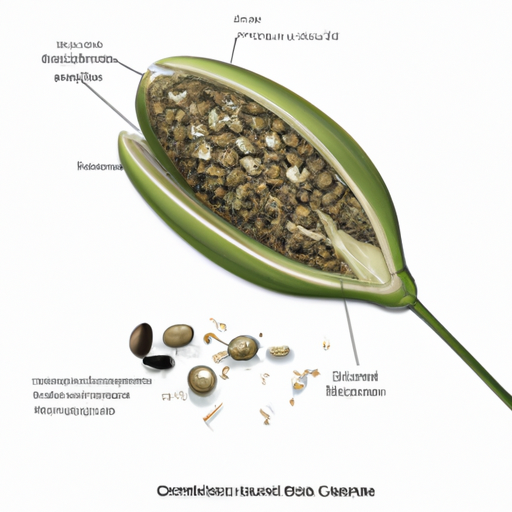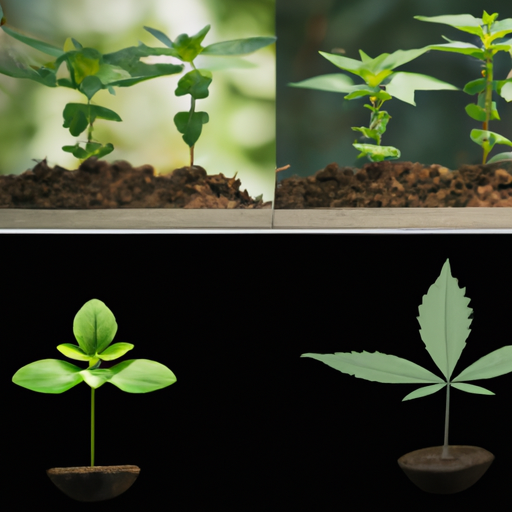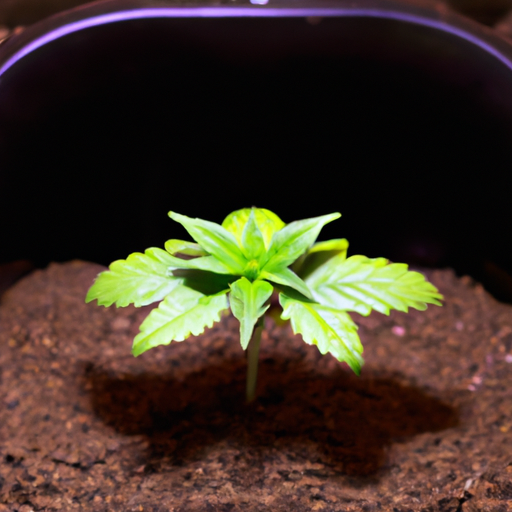This comprehensive guide titled 'From Seed to Seedling: Timing and Techniques for Cannabis Cultivators' aims to provide a detailed roadmap for cannabis cultivation from the perspective of a seed. It focuses on the critical stages of growth, effective techniques, and the perfect timing to ensure a successful cultivation process. The goal is to enlighten both novice and expert cultivators on the nuances of the 'cannabis seed to seedling' phase and enhance their cannabis cultivation techniques.
Understanding the Cannabis Seed: The Genesis of Life?
The cannabis seed is the beginning of life for any cannabis plant. It contains the genetic blueprint that determines the plant's characteristics, from its growth pattern to its potency. Understanding the cannabis seed is crucial for successful cultivation.
At a glance, a cannabis seed may seem small and unassuming, but it holds within it the potential for a thriving plant. Each seed is encased in a protective shell, which shields it from external factors and helps it survive until the conditions are ideal for germination.
Inside the seed, there are two main components: the embryo and the endosperm. The embryo is the tiny plant-to-be, consisting of the cotyledons, which will develop into the plant's first leaves, and the embryonic root, or radicle, which will anchor the plant in the ground. The endosperm, on the other hand, provides the necessary nutrients for the seedling's initial growth until it can establish a root system and begin photosynthesis.
The cannabis seed is a marvel of nature, designed to ensure the survival of the species. It is equipped with a protective coating that prevents moisture from entering the seed until it is time to germinate. Additionally, the seed can lay dormant for extended periods, waiting for the right conditions to sprout.
To unlock the potential within a cannabis seed, it must be properly germinated. This process involves providing the seed with the right amount of moisture and warmth to stimulate growth. There are various techniques for germination, such as placing the seed between damp paper towels or directly planting it in a growing medium. Each method has its advantages and may be influenced by factors like time constraints and personal preference.

A detailed illustration of a cannabis seed structure
The Art of Germination: Timing is Everything
Germination is a critical stage in the cannabis cultivation process, and timing plays a crucial role in its success. Knowing when to start the germination process is essential for achieving maximum yield and quality.
One key factor to consider is the maturity of the cannabis seed. Seeds that are too young may not have developed enough to germinate successfully, while seeds that are too old may have reduced viability. It is recommended to use seeds that are around 2-3 months old for optimal germination results.
Another aspect to consider is the external environment. The germination process requires a delicate balance of moisture, warmth, and oxygen. The temperature should be maintained within a specific range, typically between 70-85°F (20-30°C), to encourage optimal germination. Excessive heat or cold can delay or inhibit germination, so it is crucial to monitor the temperature carefully.
Timing is also influenced by the cultivation goals. For those aiming for an outdoor grow, germinating seeds a few weeks before the last frost date in their region ensures that the seedlings will be ready to thrive in the outdoor environment. Indoor growers, on the other hand, have more flexibility and can start the germination process at any time of the year.
When it comes to germination techniques, there are several options to choose from. Some growers prefer the traditional method of planting seeds directly in the growing medium, while others opt for pre-soaking the seeds in water or a mild nutrient solution. Each technique has its pros and cons, and the choice will depend on personal preference and experience.
Soil vs. Hydroponics: Which is the Best for Cannabis Seedlings?
When it comes to growing cannabis seedlings, cultivators often find themselves faced with the decision of whether to use soil or hydroponics as their growing medium. Both options have their advantages and disadvantages, so it's important to understand the differences and choose the method that best suits your needs and preferences.
Soil cultivation offers a more natural and traditional approach. It provides a stable and nutrient-rich medium for the seedlings to grow in. Soil contains beneficial microorganisms and nutrients that aid in the development of strong root systems. It also has excellent water retention properties, reducing the risk of over or under watering. Additionally, soil cultivation is generally more forgiving for novice growers, as it allows for some margin of error in terms of nutrient levels and pH balance.
On the other hand, hydroponics is a soilless cultivation method that involves growing plants in a nutrient-rich water solution. This method offers precise control over nutrient delivery, pH levels, and water content. It allows for faster growth rates and potentially higher yields due to the increased availability of nutrients and oxygen to the roots. Hydroponics also eliminates the risk of soil-borne pests and diseases, offering a more sterile and controlled environment for the seedlings.
However, hydroponics requires more investment and expertise to set up and maintain. It involves the use of specialized equipment such as pumps, reservoirs, and pH meters. The nutrient solution needs to be monitored and adjusted regularly to ensure optimal growth conditions. Additionally, any issue with the system can quickly affect the health of the seedlings, making it crucial to have a good understanding of hydroponic principles.

A comparative image showing cannabis seedlings grown in soil and hydroponics
"A plant's diet: Nutrition and Cannabis Seedlings"
Proper nutrition is essential for the healthy growth and development of cannabis seedlings. During this critical stage, the seedlings rely heavily on the nutrients provided to establish a strong foundation for future growth.
A well-balanced diet for cannabis seedlings includes a combination of macronutrients and micronutrients. Macronutrients, such as nitrogen (N), phosphorus (P), and potassium (K), are needed in larger quantities and play a crucial role in overall growth and development. Nitrogen promotes leaf and stem growth, phosphorus aids in root development and energy transfer, while potassium enhances overall plant health and disease resistance.
Micronutrients, including iron (Fe), manganese (Mn), and zinc (Zn), are required in smaller amounts but are equally important. These micronutrients are involved in various enzymatic processes and play a critical role in ensuring optimal nutrient uptake and utilization by the seedlings.
It is important to provide the seedlings with a balanced nutrient solution or amended soil that meets their specific needs. Many commercial cannabis-specific nutrient formulations are available, formulated with the ideal ratios of macronutrients and micronutrients for each growth stage.
When fertilizing cannabis seedlings, it's crucial to start with a diluted nutrient solution to avoid overfeeding. Gradually increase the nutrient concentration as the seedlings grow and develop. Monitoring the pH of the nutrient solution is also essential, as cannabis prefers a slightly acidic pH range of around 6.0 to 6.5 for optimal nutrient uptake.
In addition to macronutrients and micronutrients, cannabis seedlings also benefit from beneficial microbes. These microorganisms help improve nutrient availability and uptake, enhance root development, and protect against harmful pathogens. Adding beneficial microbial products to the growing medium can greatly enhance the overall health and vigor of the seedlings.
Lighting the Way: How Important is Light in the Cannabis Seed to Seedling Stage?
Light plays a crucial role in the cannabis seed to seedling stage, as it is the primary source of energy for photosynthesis. During this stage, the seedlings are in the process of developing their first set of leaves and establishing their root system. Providing the right amount and quality of light is vital for optimal growth and development.
Cannabis seedlings require a specific light spectrum to trigger photosynthesis and promote healthy growth. While they can tolerate lower light levels than mature plants, they still need sufficient light intensity to thrive. Providing seedlings with a light source that emits the appropriate spectrum, such as blue and white light, helps stimulate vegetative growth and prevents stretching or leggy growth.
To ensure proper light exposure, it is recommended to use artificial lighting sources, such as fluorescent or LED grow lights, specifically designed for cannabis cultivation. These lights can be adjusted to provide the appropriate intensity and spectrum for the seedlings.
The duration of light exposure is also essential during the seed to seedling stage. Initially, providing a continuous light cycle of 18-24 hours per day can promote faster growth and development. However, as the seedlings mature and develop their first true leaves, transitioning to a light cycle of 16-18 hours per day mimics natural outdoor conditions and supports healthy growth.
Proper light placement is another factor to consider. Placing the lights too close to the seedlings can cause heat stress and damage the delicate leaves, while placing them too far away can result in weak, elongated growth. Maintaining an optimal distance between the lights and the seedlings helps ensure uniform light distribution and prevents any light-induced issues.

A photo of a young cannabis seedling under optimum lighting conditions
Pest Control: How to Protect Your Cannabis Seedlings?
Pests can pose a significant threat to cannabis seedlings, potentially compromising their growth and overall health. Implementing effective pest control measures is crucial to protect your crop and ensure successful cultivation. There are several key strategies to consider when it comes to safeguarding your cannabis seedlings from pests.
- 1. Prevention is Key:
Taking proactive measures to prevent pests from infesting your cannabis seedlings is the first line of defense. Start by maintaining a clean and tidy growing environment, removing any debris or plant material that could harbor pests. Regularly inspect your seedlings for signs of pests, such as chewed leaves or webbing, and promptly address any issues you find. - 2. Natural Predators and Beneficial Insects:
Introducing natural predators and beneficial insects to your growing area can be an effective method of pest control. For example, ladybugs and lacewings prey on common cannabis pests like aphids and mites. By releasing these beneficial insects, you can establish a natural balance and reduce the population of harmful pests. - 3. Organic Pest Control Solutions:
Using organic pest control solutions is another effective approach to protecting your cannabis seedlings. Organic insecticides, such as neem oil or insecticidal soap, can be applied to the foliage to control pests. These solutions are safe for the seedlings and do not leave harmful residues. It is important to follow the instructions carefully and apply them at the recommended intervals to achieve the best results.Regular monitoring of your cannabis seedlings is crucial to catch any pest infestations early. By identifying and addressing pest issues promptly, you can prevent them from spreading and causing significant damage. Remember to rotate your pest control methods to avoid pests developing resistance to specific treatments.
Understanding the Transition: When Does a Cannabis Seed Become a Seedling?
The transition from a cannabis seed to a seedling is an exciting and crucial stage in the cultivation process. It marks the beginning of the plant's growth and development. But when exactly does a cannabis seed become a seedling?
After germination, when the seed cracks open and the taproot emerges, the seed can be considered a seedling. This typically occurs within 24 to 72 hours after planting the seed. The taproot is the primary root that grows downward, anchoring the seedling and absorbing water and nutrients from the soil.
As the taproot develops, the seedling begins to grow its first set of true leaves. These leaves are different from the initial cotyledons, which are the embryonic leaves that provide energy to the seedling until it can perform photosynthesis. The appearance of true leaves is a significant milestone in the transition from seed to seedling.
At this stage, it is crucial to provide the seedling with the right conditions for optimal growth. This includes maintaining proper temperature, humidity, and light levels. The seedling also requires a well-draining growing medium and a gentle watering routine to prevent overwatering or waterlogging, which can stunt its growth.
Once the seedling has established its root system and developed a few sets of true leaves, it is ready for transplanting into a larger container or the final growing location. This typically occurs when the seedling is around two to three weeks old, depending on its growth rate and environmental conditions.

A series of images showing the transition of cannabis from seed to seedling
Cannabis Cultivation Techniques:
| Stage | Techniques | Timing | Environment |
|---|---|---|---|
| Seed to Seedling | Germination and Transplanting | Early Spring | Humid, Warm, and Well-Lit |
| Vegetative Growth | Fertilizing and Pruning | Late Spring | Humid, Warm, and Well-Lit |
| Flowering | Defoliation and Pollination | Late Summer | Dry, Cool, and Dark |
| Harvesting | Curing and Trimming | Early Fall | Cool and Dry |
In conclusion, understanding the journey from cannabis seed to seedling is imperative for any successful cannabis cultivator. The guide provides cultivators with the necessary timing and techniques for a successful grow. By adhering to these guidelines, cultivators can optimize their yields and produce healthy cannabis plants. The seedling stage is just the beginning of the cultivation journey, but it sets the stage for all future growth. Therefore, mastering this stage is crucial for the successful cultivation of cannabis.





